Did you know that back pain is the most common health issue in the USA, accounting for 264 million lost workdays each year?
It’s important to check fully adjustable chair ergonomic guidelines to ensure that your chair keeps you in the correct posture to prevent back pain.
Making my office chair taller was a simple solution to my tension headaches. If you also experience pain and strain after sitting at your work surface, check which regulations will improve your posture.
Table of Contents
How to Adjust Office Chair to Get the Correct Sitting Posture
Your sitting posture influences your overall health, which is why you should purchase one that supports you correctly. It is an investment in your health.
Make sure the chair provides optimum support regardless of your arrangement. Follow the instructions below to ensure your desk chair keeps you healthy. The following steps will ensure all your parts are well-adjusted for your needs.
How to Adjust the Height
Use the side lever on the chair with the up-down arrows:
- Some chairs have a knob instead of a lever.
- Ensure your elbows are at the same seat height as your desk.
 If you have a standing desk, regulate the height first, and then adjust the desk height accordingly. Read some Wirecutter drafting chair reviews to ensure you’re getting a good model for your needs.
If you have a standing desk, regulate the height first, and then adjust the desk height accordingly. Read some Wirecutter drafting chair reviews to ensure you’re getting a good model for your needs.- Check that the clearance between the front edge of the seat and the lower part of your calves fits a clenched fist.
Why it matters:
- You won’t lean over your keyboard.
- You won’t lean back and put unnecessary pressure on your lower back.
- Your circulation will be better.
- You won’t strain your upper body.
Summary: Regulate your chair height to ensure you’re not straining your back and to improve blood flow. If you need ideas, Tempur Pedic and Serta regulation allow a good height adjustment range for your needs.
Ensure Your Feet Flat is Firmly on the Floor
Sit on the chair, resting your back on the backrest, and ensure that your soles are firmly on the floor. If you can’t reach the floor, consider using a footrest.
Why it matters:
- This arrangement ensures you’re not sliding off and stressing your lumbar area.
- You’re not putting pressure on your hamstrings, so your blood circulation is optimized.
- You’re not straining your knees, so you’re avoiding pain and injuries.
Summary: Keep the soles of your feet flat on the floor and your knees bent at a 90ᵒ. That way, you’re improving your blood circulation to your feet.
Adjust the Backrest Angle
Most standard models have a lever or a knob for backrest angle regulation positioned on the right side. Adjusting the degree angle depends on your activity:
- A forward sloping offers good support when typing/ writing.
- An upright back is for working on the computer, clicking, and making phone calls.
 Keep the backrest on recline at meetings, talking on the phone, or reading.
Keep the backrest on recline at meetings, talking on the phone, or reading.
Why it matters:
- Taking pressure off your spine is important to improve posture and prevent pain.
- The correct position keeps your spine and hips aligned to prevent lumbar pain.
- A correct arrangement means less pain and strain on your neck and upper body.
Summary: Choose the arrangement properly depending on your activity. Look for ergonomic chairs on trustworthy sites like Global Furniture to ensure your chair features angle regulations.
Adjust the Chair Angle
Some ergonomic office chairs let you regulate the seat tilt. You can find the lever or knob for the job on the back right side.
- Keeping your seat parallel to the floor is comfortable for computer work.
- Tilting your seat backward is best if you have lumbar pain.
- A forward seat tilt is best to take the pressure from your hamstrings if you have poor circulation.
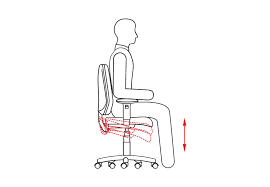 Why it matters:
Why it matters:
- Your legs won’t push into the seat, which means you’ll improve your blood circulation. You’ll also avoid leg numbness and tingling as a result.
- You’ll keep your hips open at the correct position. It helps you avoid hip and lower back pain.
Summary: Seat angle regulation reduce your lumbar and hip pain. If you have these issues, choose a chair with seat depth adjustment, such as Herman Miller’s Embody Lumbar Support Chair. Some chairs like Hon Quotient feature an advanced 2-to-1 synchro-tilt mechanism. This mechanism lifts the seat when you recline your back to ensure you’re supported in all positions.
Adjust Backrest Height
The backrest should be S-shaped to ensure your spine is kept in a neutral, anatomically correct position.
You can get either a mesh or a plush model.
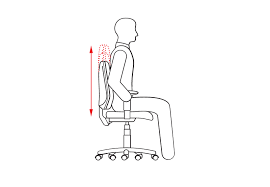 Either way, make sure the protruding lumbar part fits well into your lower back. To do this, use the lever or knob at the base of your seatback.
Either way, make sure the protruding lumbar part fits well into your lower back. To do this, use the lever or knob at the base of your seatback.
Why it matters:
- Your lumbar area is supported by the chair to minimize lumbar pain.
- You won’t strain your upper back muscles.
- It’s better for back health.
Summary: The height is important to keep your spine in a correct position, but the back shape is also important. Choose a chair with a curved backrest that contours your back, such as Lazy Boy or Master New Roma.
Adjust the Armrest Height
Poorly adjusted armrests make you hunch or lean at an uncomfortable angle. Some models don’t feature armrest regulation, so you might experience shoulder and neck strain.
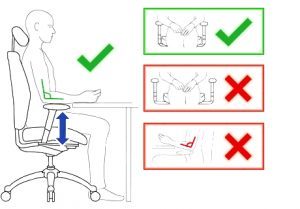 In this case, it’s wise to test the chair before getting it:
In this case, it’s wise to test the chair before getting it:
- Make sure the armrests fit under your work surface so that your arms are relaxed, with your elbow height at a 90-degree angle.
- Use an armrest height extender if your armrests can’t get high enough.
Why it matters:
- You’re avoiding strain on your upper back muscles.
- You will improve circulation in your arms.
- You avoid arthritis pain.
- You decrease the risk of tension headaches caused by neck pain.
Summary: Get a right model with multiple armrest regulation, like Steelcase Gesture. This chair moves its armrests together with your arms so that you’re supported regardless of the device you’re using.
SUMMARY: Home office chair adjustments are important to correct your posture and to alleviate pain. If you already have chronic pain, invest in a good model, such as the Embody or Gesture. Otherwise, even a cheaper ergonomic model can help you prevent pain if it has the necessary basic adjustments.
Frequently Asked Questions:
The desk chair setup is essential to keep you in an ergonomic, correct posture. But what if you can’t make these changes? Read on to find the answers to some of the most common questions.
What is the Knob on the Bottom of My Office Chair For?
The knob on the bottom of your chair is probably for tilt tension control. Some chairs recline when you push your body weight into them.
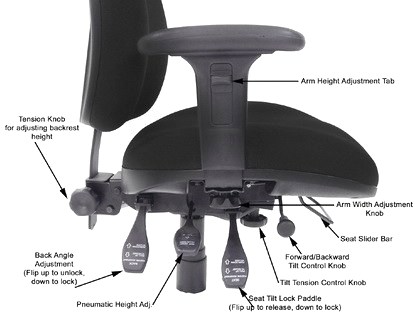
If you want to recline easily, make sure this knob is loose. If you want the firm and secure in an upright position, tighten the knob.
How to Adjust Your Office Chair Height Without Lever
If your lever broke, you first have to understand what and how that lever was activating. You can check your instructions or assembly manual for that. If you don’t have it anymore, look for one online.
Once you understand how your old lever works, find a similar-looking shaft to replace your lever. Usually, the lever activates a button inside the chair, so you need something to press that button with.
The problem is you’ll need to press the button a lot, so you’re better off repairing the lever or buying a new one.
Pro tip: If your computer chair won’t go down, use a footrest until you can fix it.
How to Fix an Office Chair That Leans Forward
If your chair leans forward uncomfortably, make sure the swivel casters aren’t broken or loose. If the problem is with the casters, you may either need to tighten their screws or replace damaged ones.

If that’s not what’s making your chair lean forward, check the seat pan for loose screws or damage. A bent seat plate or missing bolts might be causing your problem, so you’ll need to replace these.
How to Make Higher
You can make your desk chair higher by using the lever on the right side. If that doesn’t work to fit your shape, here are some instructions on how to adjust ergonomic chair height:
- Take out the screws that attach your seat to the seat pan with a screwdriver.
- Place 2×2 inch wood pieces between the seat and the pan, depending on your needs. Use long screws for the job.
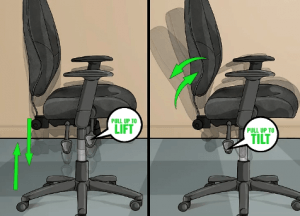 If your old wooden model has a threaded post for regulation, you need to:
If your old wooden model has a threaded post for regulation, you need to:
- Calculate the necessary height adjustment. Let’s say you need 3 inches.
- Set it upside down.
- Oil the threaded post.
- Clean the extra oil and potential debris with a clean cloth.
- Secure it by putting one foot on its base.
- Spin anti-clockwise once to increase the height by about 0.25 inches.
- Stop spinning when the chair reaches the correct. For the 3 inches, you’ll need to spin it twelve times.
How to Make Office Chair Lean Back More
First, check the official specs to ensure your chair can lean back.
Your desk chair tilt lock may be stuck in an upright arrangement. Pull out the height adjustment lever to ensure your chair can lean back and forward.
You can also loosen the tilt tension knob to make the desk chair lean back more. Press into the backrest while doing this to create a bigger recline.
In case of your tilt lock not working, check with the manufacturer for advice.
SUMMARY: If you read your instructions manual, you’ll learn how to make all the right adjustments. If something broke and the manufacturer of your chair can’t replace it, you can try all sorts of tricks. However, these changes won’t ensure a long-term correct posture. That’s why it’s best to purchase an ergonomic budget model like Serta Executive Chair until you can fix your old model.
How Do I Adjust My Office Chair Back Support?
The human body’s posture begins with the shoulders and the pelvis. Both are extremely important in the proper posture required for good posture. Correctly using these muscles ensures you have a healthy body, even if you do wear a desk chair all day long. Since the head and neck are of the highest priority, you should make sure your chair is supportive enough. It should sit straight and have back support that is supportive enough to keep your head from arching and your neck from craning forward. Your desk chair should also be adjustable so you can give your lower back and arms some extra space.
Are There Any Other Decisions To Make? It’s important to remember that while you might need the computer for several hours at a time, at your workstation, you do not need to be hunched over, the keyboard under your chin, or the mouse in your mouth. With good ergonomics, you’ll have a healthy body and be more productive in your work. When to Do My Best Work. You need to get enough rest so your brain is well-rested for you to do your best work. And you also need to do activities that are both physically and mentally stimulating. If you have a desk job that requires you to spend several hours a day in front of the computer.
What is the Proper Way to Adjust an Office Chair?
Modern office chairs have complex systems that allow for adjustment. A metal band comes out and latches onto the headrest, which lifts the headrest. The seat slowly lifts and starts tilting backward, creating an inclination, which is usually 180-degrees. A motorized mechanism pushes the backrest and reclines the seat. There are so many choices for chairs; it is important to choose the best one, and that can be confusing. You need to know the chair’s capabilities, how it’s supposed to work, and what it can do, to find the right chair for your office. Who Are the Best Repairers in the World? If you have an old, tired, or worn-out model, it can be difficult to find someone who can service it or fix it. It’s actually quite easy and inexpensive, to do.
How Do You Adjust the Tilt on an Office Chair?
The two most important things when adjusting the tilt on an office chair are what we call “effort” and “depth.” (I wrote about the effort here.) The angle of tilt: This is the angle the armrests are on. A 45-degree angle is best if you can achieve it. This is your safety angle. If your back slumps to the side, you will tip the chair forwards. Keep the back even and the chair will stay level. If it leans to one side, you’ll tip it to the other.
So this is the angle you regulate, to straighten out your back and restore balance. Tilt depth: This is the depth of the tilt, usually expressed in millimeters. If your armrests are about 1.5” under the seat, you can tilt the chair by about 0.6” if your arm is straight up. That’s your comfort angle. Use it.
How to Adjust Office Chairs for Lower Back Pain
You probably hate working in an office chair because of your lower back pain. I don’t know anyone who doesn’t. That’s why it’s so important to find the right chair, which, of course, is going to be a function of how many back problems you already have. The goal is to find the best one for your particular pain levels, and you can do that by asking a lot of questions about the chair or ergonomic products.
“It’s going to help you really dial in on what kind of chair you need to work in,” says Steve Winn, a chiropractor with 19 years of experience. “Are you working on a laptop? Do you have multiple devices? Do you sit at a desk all day?”
Frequently Asked Questions
How Do I Adjust My Lumbar Office Chair?
Adjusting the lumbar support on an office chair is an important step in ensuring proper posture and reducing the risk of back pain or discomfort. To regulate the lumbar support on your office chair, start by sitting in the chair and finding the small knob or lever located on the backrest near your lower back.
Next, adjust the lumbar support by turning the knob or pulling the lever up or down, depending on your chair’s design. Experiment with different settings until you find a comfortable level of support that promotes good posture and reduces strain on your back muscles.
Remember, the goal of lumbar support is to maintain the natural curve of your spine and reduce pressure on your lower back. With proper lumbar support, you can enjoy increased comfort and productivity throughout the workday.
What Do the Levers on My Chair Do?
If you’ve ever wondered what all those levers and knobs on your office chair do, you’re not alone! Understanding the purpose of each lever can help you customize your chair to your body and promote good posture and comfort.
The most common levers on an office chair control the height and tilt of the seat, the angle of the backrest, and the position of the armrests. The seat height lever is typically located on the right side of the chair and allows you to regulate the height of the chair to ensure that your feet are flat on the ground and your knees are at a 90-degree angle.
The tilt lever is typically located beneath the seat and allows you to regulate the angle of the seat and backrest together. This can help you find a comfortable position for your back and hips. Finally, the armrest levers are usually located beneath the armrests and allow you to adjust their height and angle to provide support for your arms and shoulders.
By taking the time to experiment with each lever, you can find the optimal settings for your body and enjoy increased comfort and productivity throughout the workday.
What is the Ideal Office Sitting Posture?
The ideal office sitting posture is a crucial aspect of maintaining physical health and productivity in a professional environment. Scientifically, an optimal sitting posture is characterized by specific principles that promote comfort, reduce the risk of musculoskeletal issues, and enhance overall well-being.
- Maintain a Neutral Spine: The backbone of an ideal sitting posture is a neutral spine, which maintains the natural curves of the spine. The lumbar (lower back) curve should be supported with proper lumbar support to prevent slouching.
- 90-Degree Angles: Ensure that your knees are bent at approximately 90 degrees with your feet flat on the floor or a footrest. This helps distribute your body weight evenly and reduces pressure on the lower back and thighs.
- Monitor and Keyboard Position: Your computer monitor should be at eye level to prevent neck strain, and the keyboard should be positioned so that your wrists remain straight when typing. Ergonomically designed office furniture and accessories can assist in achieving these positions.
- Armrests: Armrests should be adjusted so that your elbows rest comfortably at your sides, forming an approximate 90-degree angle. This minimizes strain on the shoulders and neck.
- Regular Movement: Even in the ideal sitting posture, it’s crucial to take breaks and move around periodically. Prolonged sitting, regardless of posture, can lead to health issues. Short, frequent breaks for standing or stretching are recommended.
- Chair Selection: Invest in an ergonomic chair that supports the natural curves of your spine and provides adequate lumbar support, cushioning, and adjustability to customize your sitting experience.
Adhering to these scientifically informed principles of ideal office sitting posture can significantly reduce the risk of discomfort and long-term musculoskeletal problems associated with prolonged sitting. Regular attention to your posture and workspace ergonomics can enhance your comfort and productivity while safeguarding your physical well-being.
How Should the Feet Be Positioned While Adjusting Your Chair?
The positioning of the feet while adjusting your chair is a crucial aspect of maintaining proper ergonomic alignment and promoting overall comfort. Scientifically, the ideal foot position contributes to optimal blood circulation, reduces the risk of musculoskeletal issues, and supports a neutral spine posture.
Firstly, ensure that your feet are flat on the floor, forming a right angle at the knees. This position aids in distributing body weight evenly and prevents undue pressure on the lower back and thighs. Scientific studies highlight the importance of maintaining a balanced weight distribution to reduce the risk of developing discomfort or pain associated with prolonged sitting.
To further enhance foot positioning, consider using a footrest if your feet do not comfortably reach the floor. Scientifically, a footrest can assist in maintaining proper posture by supporting the natural curvature of the spine and reducing pressure on the lower back. Adjustable footrests allow for customization based on individual height and comfort preferences.
Additionally, the distance between the back of the knees and the chair should be approximately two to four inches, promoting optimal blood circulation to the lower limbs. Scientific research underscores the significance of proper blood flow in preventing numbness and discomfort in the legs during extended periods of sitting.
In conclusion, the scientific approach to positioning your feet while adjusting your chair emphasizes the importance of a flat foot position, right-angle at the knees, and the option of a footrest for enhanced comfort and spinal alignment. Adhering to these ergonomic principles contributes to a supportive and health-conscious seated posture.
How to Fix Posture While Sitting at Desk?
Maintaining good posture while sitting at a desk is essential for preventing musculoskeletal discomfort and promoting overall health. Poor posture can lead to back, neck, and shoulder pain, as well as long-term spinal issues. Here’s a comprehensive guide on how to fix posture while sitting at a desk, grounded in scientific principles.
1. Adjust Your Chair
Seat Height: Ensure your chair height allows your feet to rest flat on the floor. Your knees should be at a 90-degree angle, and your thighs parallel to the ground. This alignment reduces strain on your lower back and legs.
Seat Depth and Width: Sit back in your chair so your back is fully supported by the backrest. There should be a small gap (about 2-4 inches) between the edge of the seat and the back of your knees. This prevents pressure on the lower legs and improves circulation.
Backrest and Lumbar Support: Adjust the backrest to support the natural curve of your spine, particularly the lumbar region. If your chair lacks adequate lumbar support, consider adding a cushion or a rolled-up towel.
2. Position Your Monitor and Desk
Monitor Height: Place your monitor at eye level, about 20-30 inches from your face. The top of the screen should be at or slightly below eye level to prevent neck strain.
Desk Height: Your desk should be at a height where your elbows are bent at a 90-degree angle when typing. Your forearms should be parallel to the ground or slightly inclined downwards.
3. Optimize Keyboard and Mouse Placement
Keyboard: Position your keyboard so your wrists remain straight while typing. Use a wrist rest if needed to maintain a neutral wrist position.
Mouse: Place your mouse close to the keyboard and at the same height. Avoid reaching, as this can strain your shoulder and arm muscles.
4. Practice Good Sitting Habits
Sit Upright: Keep your back straight, shoulders relaxed, and buttocks touching the back of the chair. Avoid slouching or leaning forward.
Feet Placement: Keep your feet flat on the floor or on a footrest. Avoid crossing your legs, as this can lead to hip and back imbalance.
5. Take Regular Breaks and Move
Microbreaks: Every 30 minutes, take a brief break to stand, stretch, or walk around. This reduces the risk of stiffness and promotes blood circulation.
Stretching Exercises: Incorporate stretches that target your neck, shoulders, back, and legs. Gentle stretching can alleviate tension and improve flexibility.
Scientific Insights
Research underscores the importance of dynamic sitting and regular movement to counteract the adverse effects of prolonged sitting. Studies suggest that maintaining a neutral spine position and periodically altering your posture can significantly reduce the risk of developing musculoskeletal disorders.
Fixing your posture while sitting at a desk involves a combination of ergonomic adjustments and mindful habits. By optimizing your chair, monitor, and desk setup, and incorporating regular breaks and stretches, you can maintain a healthy posture, enhance comfort, and prevent potential long-term health issues. Prioritizing these adjustments will not only improve your physical well-being but also boost your productivity and focus.
Final Words
These regulations are easy to make, and they ensure you will sit in a comfortable position. You should get a fully adjustable chair so that you can adjust it properly for your body.
If you keep a correct posture, you will avoid muscle strain, joint pain, and compressed discs. You will improve your blood circulation, and you will be more productive.
Read all the instructions in your user manual to ensure you’re taking advantage of all possible adjustments. Most controls have a short learning curve, so you’ll be fine. Take a few minutes each day to ensure the chair fits you properly before starting your workday.
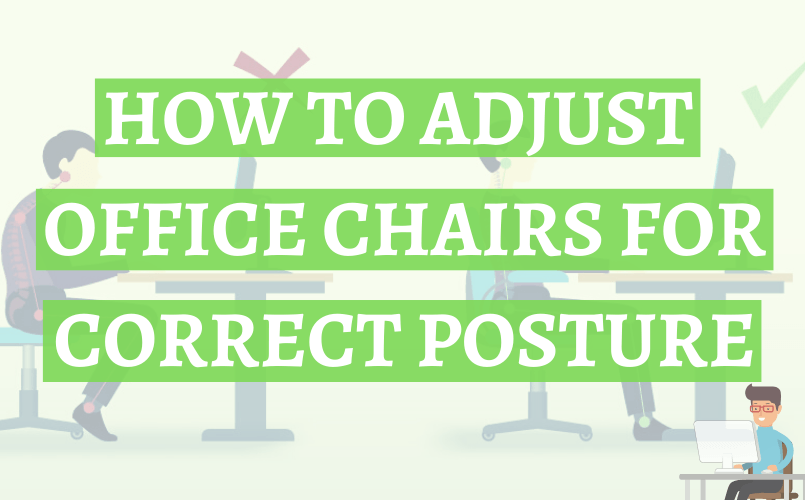
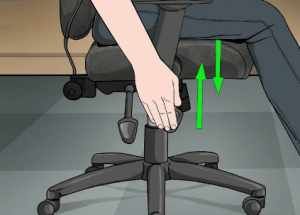 If you have a standing desk, regulate the height first, and then adjust the desk height accordingly. Read some Wirecutter drafting chair reviews to ensure you’re getting a good model for your needs.
If you have a standing desk, regulate the height first, and then adjust the desk height accordingly. Read some Wirecutter drafting chair reviews to ensure you’re getting a good model for your needs.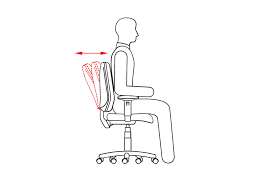 Keep the backrest on recline at meetings, talking on the phone, or reading.
Keep the backrest on recline at meetings, talking on the phone, or reading.